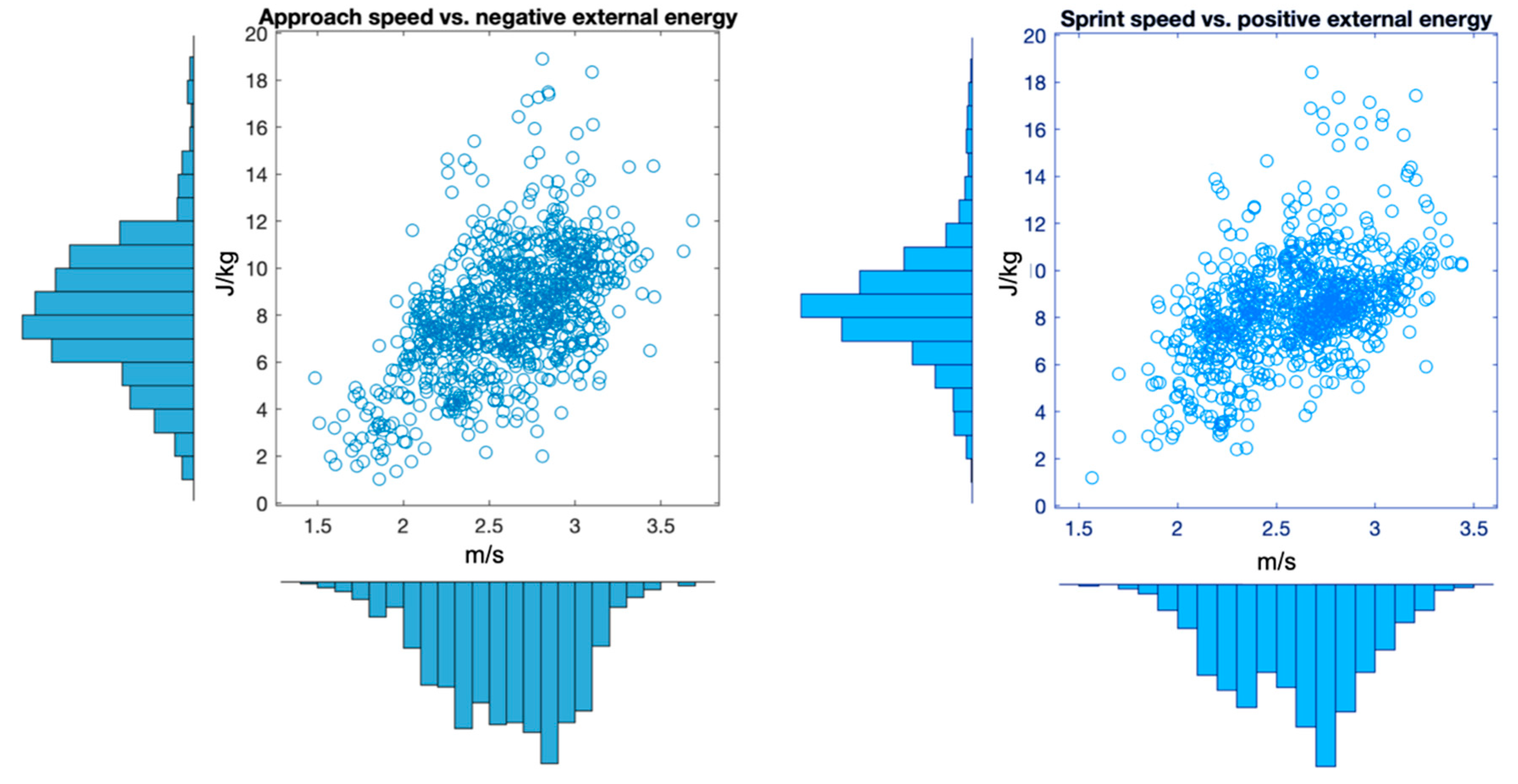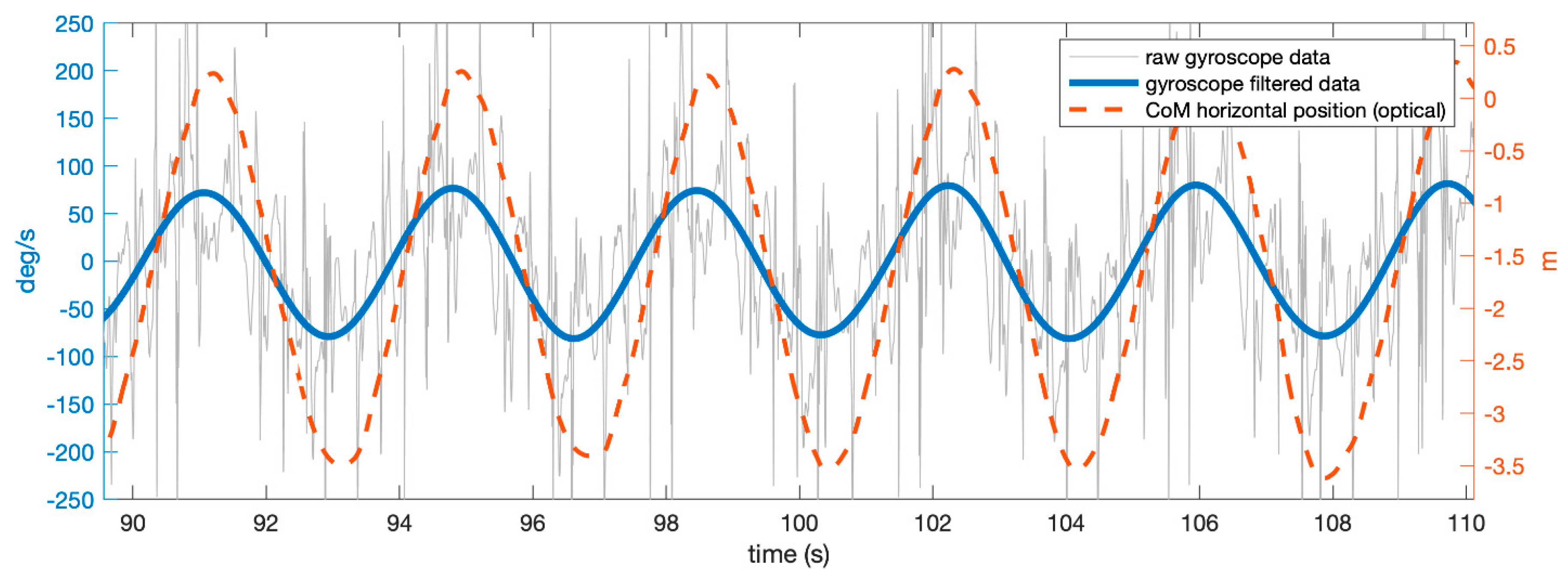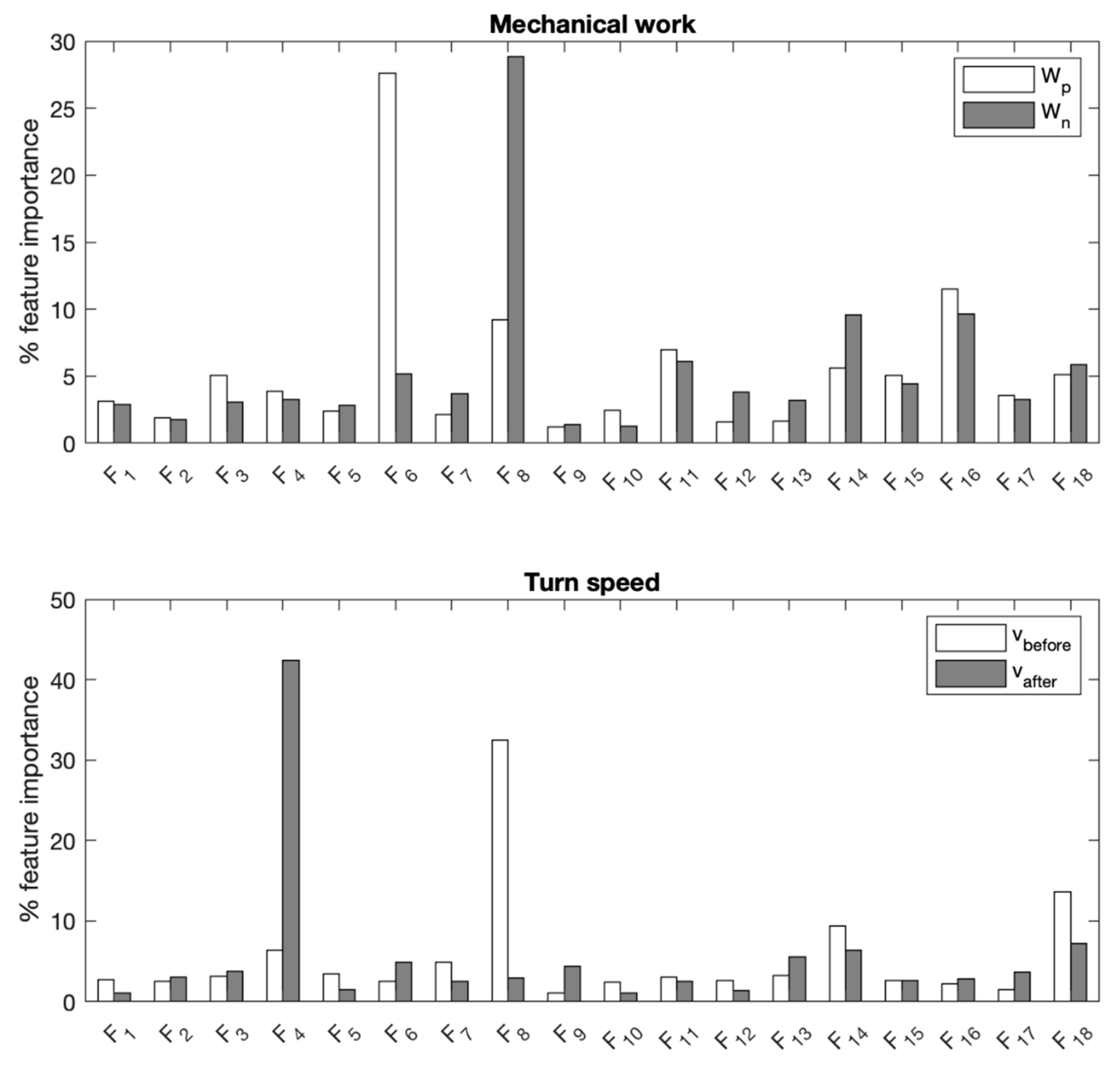Use of Machine Learning and Wearable Sensors to Predict Energetics and Kinematics of Cutting Maneuvers
Abstract
1. Introduction
2. Materials and Methods
2.1. Experimental Procedures and Equipment
2.2. Study Design and Participants
2.3. Data Processing and Features Engineering
2.4. Regression and Classification Models
- Multiple linear regression, modeling the linear relationship between predictors and the response (dependent) variables.
- Support vector regression (SVR): this technique is based on support vector machines (SVM), which in turn construct hyperplanes to define decision boundaries in a multi-dimensional space. SVR computes the parameter of a function f(x), where x is the matrix of predictors, fitting the input data with the most ε-deviation from the target y (response). As SVR is particularly suited to handle non-linear tasks, in this study we chose a Gaussian kernel.
- Boosted trees (BT): classification or regression models are in the form of a tree structure, which is built top-down from a root node, and involves partitioning data into subsets that contain common features based on the level of information gain, i.e., a decrease in entropy after a dataset is separated [33]. Boosted trees are an extension of decision trees that aggregate an ensemble of decision trees into a unique result, which reduces the chance of overfitting. The number of learners (trees) set in this study was 40.
- Artificial neural networks (ANN): a feedforward network consisting of an input, a hidden and an output layer was designed. Neurons (n = 40) in the hidden layer process the input features in accordance to hyperbolic tangent sigmoid functions. The output layer is a single neuron which returns the estimated (predicted) response. The back-propagation learning algorithm was used to update the weights and biases of the ANN. Input data was split into three subsets: 70% for training, 15% for testing and 15% for validation.
2.5. Validation
3. Results
4. Discussion
4.1. Turn Direction
4.2. Turn Speed and Mechanical Energy
4.3. Limitations and Perspectives
Author Contributions
Funding
Acknowledgments
Conflicts of Interest
References
- Hader, K.; Mendez-Villanueva, A.; Ahmaidi, S.; Williams, B.K.; Buchheit, M. Changes of direction during high-intensity intermittent runs: Neuromuscular and metabolic responses. BMC Sports Sci. Med. Rehabil. 2014, 11, e0149839. [Google Scholar] [CrossRef] [PubMed]
- Alentorn-Geli, E.; Myer, G.D.; Silvers, H.J.; Samitier, G.; Romero, D.; Lazaro-Haro, C.; Cugat, R.R.; Lázaro-Haro, C.; Cugat, R.R. Prevention of non-contact anterior cruciate ligament injuries in soccer players. Part 1: Mechanisms of injury and underlying risk factors. Knee Surg. Sports Traumatol. Arhrosc. 2009, 17, 705–729. [Google Scholar] [CrossRef] [PubMed]
- Besier, T.F.; Lloyd, D.G.; Ackland, T.R. Muscle activation strategies at the knee during running and cutting maneuvers. Med. Sci. Sports Exerc. 2003, 35, 119–127. [Google Scholar] [CrossRef]
- Read, P.J.; Oliver, J.L.; De Ste Croix, M.B.A.; Myer, G.D.; Lloyd, R.S. Neuromuscular Risk Factors for Knee and Ankle Ligament Injuries in Male Youth Soccer Players. Sports Med. 2016, 46, 1059–1066. [Google Scholar] [CrossRef] [PubMed]
- Vanrenterghem, J.; Venables, E.; Pataky, T.; Robinson, M.A. The effect of running speed on knee mechanical loading in females during side cutting. J. Biomech. 2012, 45, 2444–2449. [Google Scholar] [CrossRef] [PubMed]
- McLean, S.G.; Huang, X.; Van Den Bogert, A.J. Association between lower extremity posture at contact and peak knee valgus moment during sidestepping: Implications for ACL injury. Clin. Biomech. 2005, 20, 863–870. [Google Scholar] [CrossRef]
- Ciprandi, D.; Lovecchio, N.; Piacenza, M.; Limonta, E.; Esposito, F.; Sforza, C.; Zago, M. Energy Cost of Continuous Shuttle Running. J. Strength Cond. Res. 2017, 32, 2265–2272. [Google Scholar] [CrossRef]
- Zamparo, P.; Bolomini, F.; Nardello, F.; Beato, M. Energetics (and kinematics) of short shuttle runs. Eur. J. Appl. Physiol. 2015, 115, 1985–1994. [Google Scholar] [CrossRef]
- Cortes, N.; Onate, J.; van Lunen, B. Pivot task increases knee frontal plane loading compared with sidestep and drop-jump. J. Sports Sci. 2011, 29, 83–92. [Google Scholar] [CrossRef][Green Version]
- Zago, M.; Codari, M.; Grilli, M.; Bellistri, G.; Lovecchio, N.; Sforza, C. Determinants of the half-turn with the ball in sub-elite youth soccer players. Sports Biomech. 2016, 15, 234–244. [Google Scholar] [CrossRef]
- Zago, M.; Piovan, A.G.; Annoni, I.; Ciprandi, D.; Iaia, F.M.; Sforza, C. Dribbling determinants in sub-elite youth soccer players. J. Sports Sci. 2016, 34, 411–419. [Google Scholar] [CrossRef] [PubMed]
- David, S.; Mundt, M.; Komnik, I.; Potthast, W. Understanding cutting maneuvers—The mechanical consequence of preparatory strategies and foot strike pattern. Hum. Mov. Sci. 2018, 62, 202–210. [Google Scholar] [CrossRef] [PubMed]
- Maniar, N.; Schache, A.G.; Cole, M.H.; Opar, D.A. Lower-limb muscle function during sidestep cutting. J. Biomech. 2019, 82, 186–192. [Google Scholar] [CrossRef] [PubMed]
- Zago, M.; Esposito, F.; Bertozzi, F.; Tritto, B.; Rampichini, S.; Galvani, C.; Galli, M.; Sforza, C. Kinematic effects of repeated turns while running. Eur. J. Sport Sci. 2019, 5, 1–10. [Google Scholar] [CrossRef] [PubMed]
- Cortes, N.; Greska, E.; Kollock, R.; Ambegaonkar, J.; Onate, J.A. Changes in lower extremity biomechanics due to a short-term fatigue protocol. J. Athl. Train. 2013, 48, 306–313. [Google Scholar] [CrossRef]
- Zago, M.; Esposito, F.; Rausa, G.; Limonta, E.; Corrado, F.; Rampichini, S.; Sforza, C. Kinematic algorithm to determine the energy cost of running with changes of direction. J. Biomech. 2018, 76, 189–196. [Google Scholar] [CrossRef] [PubMed]
- Camomilla, V.; Bergamini, E.; Fantozzi, S.; Vannozzi, G. Trends supporting the in-field use of wearable inertial sensors for sport performance evaluation: A systematic review. Sensors 2018, 18, 873. [Google Scholar] [CrossRef]
- Cust, E.E.; Sweeting, A.J.; Ball, K.; Robertson, S. Machine and deep learning for sport-specific movement recognition: A systematic review of model development and performance. J. Sports Sci. 2019, 37, 568–600. [Google Scholar] [CrossRef]
- Mukhopadhyay, S.C. Wearable sensors for human activity monitoring: A review. IEEE Sens. J. 2015, 15, 1321–1330. [Google Scholar] [CrossRef]
- Aroganam, G.; Manivannan, N.; Harrison, D. Review on Wearable Technology Sensors Used in Consumer Sport Applications. Sensors 2019, 19, 1983. [Google Scholar] [CrossRef]
- Ahamed, N.U.; Benson, L.C.; Clermont, C.A.; Pohl, A.J.; Ferber, R. New Considerations for Collecting Biomechanical Data Using Wearable Sensors: How Does Inclination Influence the Number of Runs Needed to Determine a Stable Running Gait Pattern? Sensors 2019, 19, 2516. [Google Scholar] [CrossRef] [PubMed]
- Kim, W.; Kim, M. On-line detection and segmentation of sports motions using a wearable sensor. Sensors 2018, 18, 913. [Google Scholar] [CrossRef] [PubMed]
- Zhang, Y.; Ma, Y. Application of supervised machine learning algorithms in the classification of sagittal gait patterns of cerebral palsy children with spastic diplegia. Comput. Biol. Med. 2019, 106, 33–39. [Google Scholar] [CrossRef] [PubMed]
- Gastin, P.B.; Mclean, O.C.; Breed, R.V.P.; Spittle, M. Tackle and impact detection in elite Australian football using wearable microsensor technology. J. Sports Sci. 2014, 32, 947–953. [Google Scholar] [CrossRef] [PubMed]
- Dalen, T.; JØrgen, I.; Gertjan, E.; Havard, H.G.; Ulrik, W. Player load, acceleration, and deceleration during forty-five competitive matches of elite soccer. J. Strength Cond. Res. 2016, 30, 351–359. [Google Scholar] [CrossRef] [PubMed]
- Nedergaard, N.J.; Kersting, U.; Lake, M. Using accelerometry to quantify deceleration during a high-intensity soccer turning manoeuvre. J. Sports Sci. 2014, 32, 1897–1905. [Google Scholar] [CrossRef] [PubMed]
- Bangsbo, J.; Iaia, F.M.; Krustrup, P. The Yo-Yo intermittent recovery test: A useful tool for evaluation of physical performance in intermittent sports. Sports Med. 2008, 38, 37–51. [Google Scholar] [CrossRef]
- Mapelli, A.; Zago, M.; Fusini, L.; Galante, D.; Colombo, A.; Sforza, C. Validation of a protocol for the estimation of three-dimensional body center of mass kinematics in sport. Gait Posture 2014, 39, 460–465. [Google Scholar] [CrossRef]
- Zago, M.; Motta, A.F.; Mapelli, A.; Annoni, I.; Galvani, C.; Sforza, C. Effect of leg dominance on the center-of-mass kinematics during an inside-of-the-foot kick in amateur soccer players. J. Hum. Kinet. 2014, 42, 51–61. [Google Scholar] [CrossRef]
- Zago, M.; Mapelli, A.; Shirai, Y.F.; Ciprandi, D.; Lovecchio, N.; Galvani, C.; Sforza, C. Dynamic balance in elite karateka. J. Electromyogr. Kinesiol. 2015, 25, 894–900. [Google Scholar] [CrossRef]
- Willems, P.A.; Cavagna, G.A.; Heglund, N.C.; Umana, F.; Chelmsford, S. External, internal and total work in human locomotion. J. Exp. Biol. 1995, 393, 379–393. [Google Scholar]
- Wang, W.H.; Hsu, Y.L.; Chung, P.C.; Pai, M.C. Predictive Models for Evaluating Cognitive Ability in Dementia Diagnosis Applications Based on Inertia-and Gait-Related Parameters. IEEE Sens. J. 2018, 18, 3338–3350. [Google Scholar] [CrossRef]
- Safavian, S.R.; Landgrebe, D. A Survey of Decision Tree Classifier Methodology. IEEE Trans. Syst. Man Cybern. 1991, 21, 660–674. [Google Scholar] [CrossRef]
- Little, M.A.; Varoquaux, G.; Saeb, S.; Lonini, L.; Jayaraman, A.; Mohr, D.C.; Kording, K.P. Using and understanding cross-validation strategies. Perspectives on Saeb et al. Gigascience 2017, 5, gix020. [Google Scholar] [CrossRef] [PubMed]
- Stevens, T.G.A.; De Ruiter, C.J.; Van Maurik, D.; Van Lierop, C.J.W.; Savelsbergh, G.J.P.; Beek, P.J. Measured and estimated energy cost of constant and shuttle running in soccer players. Med. Sci. Sports Exerc. 2015, 47, 1219–1224. [Google Scholar] [CrossRef] [PubMed]
- Mertens, J.C.; Boschmann, A.; Schmidt, M.; Plessl, C. Sprint diagnostic with GPS and inertial sensor fusion. Sports Eng. 2018, 21, 441–451. [Google Scholar] [CrossRef]
- Besier, T.F.; Lloyd, D.G.; Cochrane, J.L.; Ackland, T.R. External loading of the knee joint during running and cutting maneuvers. Med. Sci. Sports Exerc. 2001, 33, 1168–1175. [Google Scholar] [CrossRef]
- Beato, M.; Bartolini, D.; Ghia, G.; Zamparo, P. Accuracy of a 10 Hz GPS Unit in Measuring Shuttle Velocity Performed at Different Speeds and Distances (5–20 M). J. Hum. Kinet. 2016, 54, 15–22. [Google Scholar] [CrossRef]
- Varley, M.C.; Fairweather, I.H.; Aughey, R.J. Validity and reliability of GPS for measuring instantaneous velocity during acceleration, deceleration, and constant motion. J. Sports Sci. 2012, 30, 121–127. [Google Scholar] [CrossRef]
- Rawstorn, J.C.; Maddison, R.; Ali, A.; Foskett, A.; Gant, N. Rapid directional change degrades GPS distance measurement validity during intermittent intensity running. PLoS ONE 2014, 9, e93693. [Google Scholar] [CrossRef]
- Aughey, R.J. Applications of GPS Technologies to Field Sports Robert. Int. J. Sports Physiol. Perform. 2011, 6, 295–310. [Google Scholar] [CrossRef] [PubMed]
- Chau, T. A review of analytical techniques for gait data. Part 2: Neural network and wavelet methods. Gait Posture 2001, 13, 102–120. [Google Scholar] [CrossRef]




| Variable | Description | Unit | Mean | SD | CV | Min | Max |
|---|---|---|---|---|---|---|---|
| R1 | Positive work | J/kg | 8.49 | 2.35 | 0.28 | 1.18 | 18.44 |
| R2 | Negative work | J/kg | 8.17 | 2.73 | 0.33 | 1.02 | 18.91 |
| R3 | Speed before turn | m/s | 2.60 | 0.38 | 0.15 | 1.49 | 3.69 |
| R4 | Speed after turn | m/s | 2.59 | 0.33 | 0.13 | 1.57 | 3.44 |
| R5 | Turn side | cat. | - | - | - | ||
| F1 | Player load | A.U. | 190.6 | 62.6 | 0.33 | 67.3 | 407.4 |
| F2 | Positive accx integral | m/s | 325.8 | 86.0 | 0.26 | 125.7 | 584.0 |
| F3 | Positive accy integral | m/s | 528.00 | 96.1 | 0.18 | 267.4 | 846.3 |
| F4 | Positive accz integral | m/s | 238.7 | 67.6 | 0.28 | 82.0 | 435.1 |
| F5 | Negative accx integral | m/s | −328.7 | 89.4 | 0.27 | −587.1 | −107.8 |
| F6 | Negative accy integral | m/s | −508.8 | 89.2 | 0.18 | −810.1 | −263.4 |
| F6 | Negative accz integral | m/s | −251.7 | 79.0 | 0.31 | −504.5 | −93.4 |
| F7 | Norm acc RMS | m/s2 | 7.59 | 3.57 | 0.47 | 1.19 | 21.04 |
| F8 | Acceleration skewness | - | 4.95 | 1.35 | 0.27 | 2.08 | 9.00 |
| F9 | Acceleration kurtosis | - | 35.8 | 18.5 | 0.52 | 7.6 | 98.4 |
| F10 | Gyroscopex integral | rad | 9.9·103 | 1.4·104 | 1.44 | −2.9·104 | 4.7·104 |
| F11 | Gyroscopey integral | rad | 0.9·103 | 6.7·104 | n.a. | −8.5·104 | 8.6·104 |
| F12 | Gyroscopez integral | rad | −45.3 | 3.8·104 | n.a. | −6.0·104 | 6.1·104 |
| F13 | Gyroscope norm RMS | rad/s | 2.4·103 | 1.7·103 | 0.69 | 0.3·103 | 7.9·103 |
| F14 | Gyroscope skewness | - | 4.64 | 1.61 | 0.35 | 0.41 | 9.31 |
| F15 | Gyroscope kurtosis | - | 32.8 | 20.1 | 0.61 | 2.41 | 104.0 |
| F17 | , before | m | −0.39 | 0.26 | 0.65 | −1.08 | 0.36 |
| F18 | , after | m | 0.41 | 0.26 | 0.62 | −0.35 | 1.12 |
| Response | Regression Model | R2 | RMSE | MAE |
|---|---|---|---|---|
| Positive work (J) | Multilinear regression | 0.36 | 1.96 | 1.30 |
| Support vector regression | 0.43 | 1.85 | 1.14 | |
| Boosted trees | 0.39 | 1.91 | 1.22 | |
| Artificial neural network | 0.39 | 2.40 | 1.80 | |
| Negative work (J) | Multilinear regression | 0.35 | 2.27 | 1.66 |
| Support vector regression | 0.42 | 2.14 | 1.41 | |
| Boosted trees | 0.41 | 2.16 | 1.49 | |
| Artificial neural network | 0.44 | 2.34 | 1.84 | |
| Speed before (m/s) | Multilinear regression | 0.53 | 0.26 | 0.21 |
| Support vector regression | 0.65 | 0.23 | 0.17 | |
| Boosted trees | 0.60 | 0.24 | 0.19 | |
| Artificial neural network | 0.66 | 0.23 | 0.18 | |
| Speed after (m/s) | Multilinear regression | 0.47 | 0.25 | 0.20 |
| Support vector regression | 0.65 | 0.20 | 0.15 | |
| Boosted trees | 0.62 | 0.21 | 0.16 | |
| Artificial neural network | 0.69 | 0.19 | 0.15 |
© 2019 by the authors. Licensee MDPI, Basel, Switzerland. This article is an open access article distributed under the terms and conditions of the Creative Commons Attribution (CC BY) license (http://creativecommons.org/licenses/by/4.0/).
Share and Cite
Zago, M.; Sforza, C.; Dolci, C.; Tarabini, M.; Galli, M. Use of Machine Learning and Wearable Sensors to Predict Energetics and Kinematics of Cutting Maneuvers. Sensors 2019, 19, 3094. https://doi.org/10.3390/s19143094
Zago M, Sforza C, Dolci C, Tarabini M, Galli M. Use of Machine Learning and Wearable Sensors to Predict Energetics and Kinematics of Cutting Maneuvers. Sensors. 2019; 19(14):3094. https://doi.org/10.3390/s19143094
Chicago/Turabian StyleZago, Matteo, Chiarella Sforza, Claudia Dolci, Marco Tarabini, and Manuela Galli. 2019. "Use of Machine Learning and Wearable Sensors to Predict Energetics and Kinematics of Cutting Maneuvers" Sensors 19, no. 14: 3094. https://doi.org/10.3390/s19143094
APA StyleZago, M., Sforza, C., Dolci, C., Tarabini, M., & Galli, M. (2019). Use of Machine Learning and Wearable Sensors to Predict Energetics and Kinematics of Cutting Maneuvers. Sensors, 19(14), 3094. https://doi.org/10.3390/s19143094








